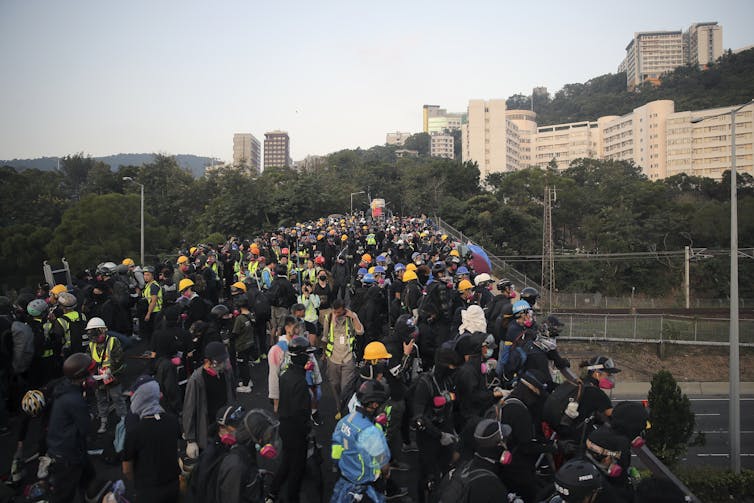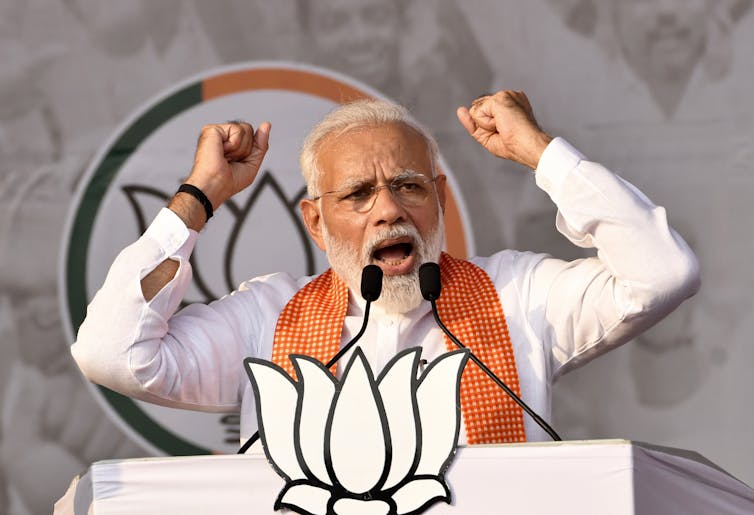So you want to be an autocrat? Here's the 10-point checklist
- Written by Shelley Inglis, Executive Director, University of Dayton Human Rights Center, University of Dayton
Democracy is in trouble, despite popular uprisings and dynamic social movements in Lebanon[1], Hong Kong[2] and across Europe[3] and Latin America[4].
Scholars say countries across the globe are experiencing a rise in autocratic rule[5], with declines in democratic ideals and practice. Autocratic rule – also known as authoritarianism – is when one leader or political party exercises complete power to govern a country and its people.
The year 2008 was when democracy peaked, according to a prominent democracy advocacy group, Freedom House. That’s when the world had the highest percentage ever of fully “free countries,” at 46.1%.[6]
That declined to 44.1% in 2018, though full or partial democracy[7] is still the most common[8] form of governance.
Definitions of democracy vary[9]. All citizens in a democracy have the ability to vote in elections, which should be free and fair. Independent media, freedom of speech and assembly and the rule of law feature in most contemporary perceptions of democracy.
Democratic declines are most notable in the regions with the world’s largest concentration of democracies[10]. That includes Europe, North America and Latin America.
One example: The United States in 2018 was rated a “flawed democracy,” dropping from 21st to 25th place[11] among 167 countries and territories.
In the old days, autocrats often came to or retained power through military coups and violent crackdowns. Now[12] the shift from democracy to autocracy is slower and less obvious[13].
While control over security forces remains essential in the autocratic playbook, overt strong-arm tactics aren’t.
 Pro-democracy protests, like this one in Hong Kong on Nov. 13, 2019, have erupted across the globe during a rise in authoritarian rule.
AP/Kin Cheung[14]
Pro-democracy protests, like this one in Hong Kong on Nov. 13, 2019, have erupted across the globe during a rise in authoritarian rule.
AP/Kin Cheung[14]
Top 10 list
I spent more than 15 years with the United Nations, where I advised governments and democracy advocates on how to strengthen the rule of law, human rights and democratic governance. I’m now a scholar of international law[15].
I’ve learned that today’s leaders with authoritarian tendencies aren’t just interested in using brute force to rise to power.
They are smarter, more resilient and can adjust[16] their methods to take account of new developments, like modern technologies and a globalized economy.
Here are some of the newest tactics used by would-be authoritarians:
1. Extend executive power
The mainstay of today’s authoritarianism[17] is strengthening your power while simultaneously weakening government institutions, such as parliaments and judiciaries, that provide checks and balances.
The key is to use legal means that ultimately give democratic legitimacy to the power grab[18]. Extreme forms of this include abolishing presidential term limits, which was done in China[19]; and regressive constitutional reforms to expand presidential power, like in Turkey[20].
2. Repress dissent and citizen efforts to hold government accountable
Restrictions on funding and other bureaucratic limitations silence the ability of the people to hold accountable those in power[21]. More than 50 countries have passed laws that stifle citizen groups. Democracies[22] have also jumped on this bandwagon. Limitations on permits for public protest, detention of protesters and excessive use of force to break up demonstrations[23] are frequently used tools.
3. Capture elite support and, when needed, demonize them too
Economic growth and prosperity are critical to retaining elite or oligarchical support for autocratic leaders. Whether through state-owned businesses, media conglomerates or more sophisticated connections between governments and free-market corporations, money and politics, translated into government favors for the rich, can be a toxic mix for democracy.
Ironically, popular distaste with elite corruption is so high that modern autocratic populists, such as President Jair Bolsonaro in Brazil, have even risen to power on anti-corruption promises[24].
4. Appeal to populism and nationalism
Most would-be autocratic leaders today exploit existing tensions within complex societies in order to solidify their support.
In many places, fears of migrants and refugees have fueled resurgent nationalism[25], driving policies like U.K.‘s Brexit. In India, religiously based nationalism has maintained the power of Prime Minister Narendra Modi[26].
Blaming external forces for a country’s problems, such as Hungarian leader Viktor Orban’s demonization of George Soros[27], a Hungarian-born philanthropist who supports democracy-building, is also common.
 India’s Prime Minister Narendra Modi has maintained power in part based on religious nationalism.
AP file photo[28]
India’s Prime Minister Narendra Modi has maintained power in part based on religious nationalism.
AP file photo[28]
5. Control information at home; misinform abroad
While propaganda and state-owned media is not new, control of modern technology and information has become a key battleground.
China has developed sophisticated technologies to censor and prevent[29] the circulation of unwanted information and to track individuals in society[30].
Russia is at the vanguard of state media control at home while generating misinformation abroad[31]. Many smaller countries have used internet blackouts[32] to block organizing and communicating by social movements.
6. Cripple the opposition
Damaging the opposition parties, while not completely destroying them, is now essential. Infiltrating parties, co-opting members and using pure scare tactics are some possible actions in the autocrat’s playbook. This serves the purpose of retaining a target for pseudo-political competition while also stymieing the potential for new, more democratic forces to gain traction.
7. Covert election manipulation
Mostly gone are the days of vote-rigging and vote-buying as a path to power. Would-be autocrats have found cleverer ways to tilt the playing field in their favor. These new tactics include hampering media access, gerrymandering, changing election and voter eligibility rules and placing allies on electoral commissions[33].
8. Play the emergency card
Some autocratic leaders continue to use traditional strong-arm tactics, like declaring states of emergency, to enable further repression.
Since 2001, using the threat of terrorism or organized crime has played well for furthering autocratic rule. President Rodrigo Duterte’s drug war, which seems to have resulted in thousands dead[34] in the Philippines, is one illustration.
Since an attempted coup in 2016 up until 2018, for example, Turkey was under a state of emergency which enabled President Recep Tayyip Erdogan to jail and persecute academics, government officials, media and human rights advocates[35].
9. Extend your model and influence
Today’s autocratic rulers are not keeping to themselves.
Using the international stage and their growing economic prowess, countries like China are spreading their influence through funding initiatives such as the Belt and Road[36] to build infrastructure across Asia to Europe.[37] They’re hiring professional consultants to advise and lobby foreign capitals for[38] policies that reinforce their power.
10. Learn and share
Characterized as “autocratic learning[39]” by scholars, national authorities from Russia, China, Iran, Venezuela, Belarus, Syria and other places are developing and exchanging models for containing threats of social movements and the so-called “color revolutions.”[40]
International meetings and intergovernmental clubs can provide a platform for exchange. For example, Prime Minister Hun Sen of Cambodia has successfully rallied neighbor governments to help oppress opposition to his rule using the regional organization ASEAN[41]. Government officials in Malaysia recently blocked Cambodian opposition members from returning to their country via Malaysia.
Direction unknown
Some experts claim the world is at a “tipping point”[42] where decreasing faith in democracy will drive the dominance of autocracy globally.
The social movements of today inspire some hope that civil society – a key ingredient for democracy – though under pressure, is fighting the trend.
Nonetheless, strengthening democracy across the globe will prove impossible if even the most established democracies today fall prey to the tactics of would-be autocrats.
[ Deep knowledge, daily. Sign up for The Conversation’s newsletter[43]. ]
References
- ^ Lebanon (www.cnn.com)
- ^ Hong Kong (www.bbc.com)
- ^ across Europe (www.theguardian.com)
- ^ Latin America (www.washingtonpost.com)
- ^ rise in autocratic rule (www.tandfonline.com)
- ^ “free countries,” at 46.1%. (freedomhouse.org)
- ^ partial democracy (scholar.harvard.edu)
- ^ most common (www.v-dem.net)
- ^ of democracy vary (doi.org)
- ^ world’s largest concentration of democracies (www.v-dem.net)
- ^ 21st to 25th place (www.eiu.com)
- ^ Now (www.researchgate.net)
- ^ slower and less obvious (www.tandfonline.com)
- ^ AP/Kin Cheung (www.apimages.com)
- ^ a scholar of international law (udayton.edu)
- ^ are smarter, more resilient and can adjust (freedomhouse.org)
- ^ mainstay of today’s authoritarianism (muse.jhu.edu)
- ^ ultimately give democratic legitimacy to the power grab (theconversation.com)
- ^ in China (www.nytimes.com)
- ^ in Turkey (www.reuters.com)
- ^ silence the ability of the people to hold accountable those in power (www.amnesty.org)
- ^ Democracies (www.openglobalrights.org)
- ^ excessive use of force to break up demonstrations (news.un.org)
- ^ on anti-corruption promises (www.reuters.com)
- ^ fueled resurgent nationalism (www.pri.org)
- ^ Prime Minister Narendra Modi (www.washingtonpost.com)
- ^ Viktor Orban’s demonization of George Soros (www.theguardian.com)
- ^ AP file photo (www.apimages.com)
- ^ censor and prevent (freedomhouse.org)
- ^ track individuals in society (www.youtube.com)
- ^ generating misinformation abroad (freedomhouse.org)
- ^ internet blackouts (www.cnn.com)
- ^ placing allies on electoral commissions (muse.jhu.edu)
- ^ in thousands dead (www.nytimes.com)
- ^ and human rights advocates (www.npr.org)
- ^ Belt and Road (www.cfr.org)
- ^ Asia to Europe. (theconversation.com)
- ^ to advise and lobby foreign capitals for (freedomhouse.org)
- ^ autocratic learning (rsa.tandfonline.com)
- ^ social movements and the so-called “color revolutions.” (doi.org)
- ^ organization ASEAN (www.nytimes.com)
- ^ “tipping point” (www.the-american-interest.com)
- ^ Sign up for The Conversation’s newsletter (theconversation.com)
Authors: Shelley Inglis, Executive Director, University of Dayton Human Rights Center, University of Dayton
Read more http://theconversation.com/so-you-want-to-be-an-autocrat-heres-the-10-point-checklist-125908


